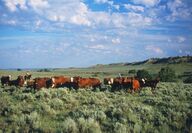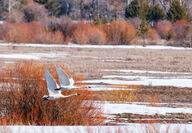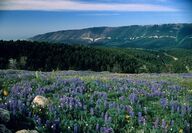Sorted by date Results 1 - 25 of 511

"Colorado is high, having more peaks within its borders than any other state. Wyoming is wide, with the breadth of the plains between the Bighorns and the Grand Tetons. California is handsome, with a splendor of success. It takes all three adjectives to describe Montana." In 1941, Donald Curloss Peattie, a naturalist of the 1920's through the 1950s, included these words in his book "The Road of a Naturalist." In 1943, Montana newsman and writer Joseph Kinsey Howard took the...

Two years ago when Montana Fish, Wildlife and Parks quietly unveiled a proposal to put Habitat Montana funds toward 30- and 40-year conservation leases, proponents described it as a "new conservation planning tool" while opponents warned of a "sea change" that could weaken one of the state's most popular habitat protection programs. Now, with Fish and Wildlife Commission approval secured for the first round of Habitat Conservation Leases and another set of agreements open for...

When full-scale war erupted in Europe in September 1939 as Hitler's troops marched into Poland, merchant seamen docked in U.S. ports found themselves stranded. Great Britain refused to grant safe passage home to the crews of German and Italian ships because it did not want the ships or their crews to be used in the war against them. When the crews began to sabotage their own ships to keep them out of British hands, the men were taken off and sent first to Ellis Island and...

Red desert, ice caves and wild horses are symbols of a most unique piece of Montana's mountain country – the island-like Pryor Mountains of south-central Montana. From the Yellowstone River Valley and the big-little town of Billings, these Pryors appear as hills when compared to the towering Beartooths 30 miles to the west. Looks are deceiving, though. Flying just beyond their flanks, especially along the east face, reveals a steep, rugged and high landscape. Named after N...

"Gerrymander," "blue states," and "red tape." These words populate headlines and newspaper articles regularly, with many writers taking their meaning for granted, but a look through history can reveal surprising changes in meaning over time. In a political landscape challenged by personal interpretation, etymology can be a reliable narrator. Tracing a word's emergence and exploring the circumstances behind any changes in meaning offers a window into the surrounding historical...

This piece was penned several years ago for Big Sky's Lone Peak Lookout newspaper owing to the increase in bear and people encounters in the Madison and Gallatin ranges. What the article discusses is pertinent to any wild country in the state, so we bring it back as a reminder. Be it biking, horseback riding or hiking, as more and more folks head out to enjoy the trails of the wilderness and national park lands near Big Sky, bear and human meetings are bound to increase. The...

Our region is at a critical time in its energy landscapes, navigating a complex network of resources, policies, and environmental concerns. This latest winter was a great case study for the reliability problem of intermittent green sources that are being pushed nationwide. In Montana, Northwestern Energy spokesperson Jo Dee Black commented in January, "Wind and solar generation could not produce much if any, power during the extreme cold." In Washington, Grant County PUD...

Hooper Park once again found itself awash in brightly colored plastic eggs on Easter Sunday as Lincoln Volunteer Fire Rescue once again hosted their annual Easter Egg Hunt March 31. For about an hour, kids ranging in age from Pre-K through sixth grade scoured areas designated by their grade level. For the youngest kids it was a scramble to gather eggs scattered around the main oval at the park, while kids from second grade oan up scattered hither and thither as they searched...

A pair of Steller's Jays spent time hunting insects ion the bark of Ponderosa pines East of Hooper park on Easter Sunday, March 31. Steller's Jays are common in the forests of the western US, including Montana. Unlike the mountain bluebird, which spends its time in open fields, the jays can be a bit harder to spot as as their dark blue and black coloring allow them to blend into the shadows of the trees in which they roost. Although they often referred to as blue jays,...

More than one-fifth of the continental U.S. is currently experiencing moderate to exceptional drought, according to the U.S. Drought Monitor. Winter storms brought heavy (in some areas, record-setting) rainfall and flooding to California, offering the state an expected two-year reprieve from widespread droughts, that covered nearly 100% of the state from 2020-22. But in other parts of the country, especially dry conditions continue. New Mexico currently is the state with the...

It took more than 60 years to create Glacier National Park, which is the foundation of the much larger natural system called the Crown of the Continent that we study and celebrate today. The events that led to the formation of the park and the surrounding ecosystem are regarded today as the bedrock of the conservation movement in America. What follows then is a timeline as we see it: 1849 – George Bird Grinnell born in Brooklyn, N.Y. – Sept. 20, 1849 George Bird Grinnell was...

Fewer Americans moved in 2022, according to the latest census data, but of those who did, 1 in 5 moved to a different state. Population growth has returned to pre-pandemic norms; Southern states continued to record influxes in population, while the Northeast saw the biggest drops, particularly in New York and Pennsylvania. These trends largely continued into last year, according to United Van Lines' annual movers study. States with the most inbound moves in 2023 were Vermont,...

On about Dec. 21, the occasion of the winter solstice, the sun takes a brief respite on the tropic of Capricorn at 23 1/2 degrees south latitude. Then it begins its six-month odyssey north for a rendezvous with the tropic of Cancer at 23 1/2 degrees north latitude. Along the way, at a precise second in March, its rays are directly overhead on the equator, declaring the Spring Equinox. This year that instant occurs at 10:57 a.m. Montana time on Thursday, March 20. In Montana,...

Farm numbers across the United States are dwindling and the mountain states are no exception. Our country lost 7 percent of farms from 2017 to 2022, and all of the mountain states were above the national average. As a farmer in the region, I understand the stress of this profession, and if our country continues on its current trajectory our region's agricultural future looks bleak – more consolidation and less food security. From 2017 to 2022, Idaho, Montana, Washington, a...

The 1970s was a tumultuous time, full of upheaval on many fronts, from the end of the Vietnam War to the dawn of personal computers. It makes sense that its music had a similar helter-skelter feel. The early '70s were a musical melting pot where rock, reggae, funk, and pop could coexist. Ingenuity was essential, and as artists were wary of the mainstream music industry, they began doing things unconventionally and bolder than ever. Punk and funk rose to popularity after the...

When asked about the origins of daylight saving time, you may imagine farmers in the distant past getting an extra hour of sun to tend to animals and crops. If you do, you're not alone. The myth that farmers are at the root of daylight saving time has proliferated a common understanding of the practice for a long time. But if the agriculture industry didn't advocate for the start of daylight saving time—and evidence suggests that farmers were, in fact, opposed to its i...

David Alt, author and a retired professor of geology at the University of Montana, explains why gold was found in Grasshopper Creek and the surrounding gulches. "At Bannack, as in many gold mining districts, much of the production came fast and early from bonanza deposits in stream placers. Early miners working the gravels in the streambed skimmed the cream off the district, leaving the hardest work and leanest pickings for those who came later. That happens because streams...

"In 1880, Nate Leavengood's meadow, where Anaconda now stands, was a lush and quiet place. As far as the eye could see in all directions there was nothing but the valley, the swelling foothills and mountain ramparts...four years later, the meadow was gone...there had been no gradual encroachment of civilization, no creeping in of small farms and little stores. There was no village. First there was nothing, and then all of a sudden there was the world's largest smelter and...

At one time, they were feared Plains warriors. Historians believe the Blackfeet, forced out of their ancestral grounds in today's upper Great Lakes region by white advancement, were one of the first Native American tribes to head West. Though there are several stories on how they received their name, the most plausible is that their moccasins were blackened from the long journey across the prairie to reach what would become Montana. The Blackfeet band now living on the Blackfe...

Abraham Lincoln, the sixteenth President of the United States, was born in a single-room log cabin on Sinking Spring Farm in LaRue County, Kentucky on February 12, 1809. He was the son of Thomas Lincoln, an illiterate pioneer farmer, and Nancy Hanks Lincoln, who died when Abraham was nine years old. It was Thomas Lincoln's second wife, Sarah Bush Johnston who, while illiterate herself, recognized Abraham's "uncommon natural talents" and encouraged his famous bookishness....

Call it 670 miles or perhaps more precisely 674 miles, but either way, the Yellowstone River remains the nation's longest undammed waterway. It's a great river that gathers some of the finest mountain and prairie topography on the planet as it passes peaks reaching 12,000 feet in elevation, the largest high-mountain lake on the continent, dense evergreen forests, buttes, colorful badlands, deep canyons and sweet-smelling sage and juniper covered hills. A good portion of this...

Snow had been falling almost continuously for a week, and it was very cold. The temperature had only risen to minus 18 degrees. Finally, late in the day, the snow and wind stopped, skies cleared rapidly, and as the sun set the temperature plummeted. Early the next morning, on Jan. 20, 1954, the Montana and continental 48 states' record cold temperature of minus 70 degrees was observed at a mining camp near the Continental Divide a short distance from Rogers Pass near Helena....

Sometimes we need to be reminded of the fact that not everything is on YouTube. Rummaging through the shelves of the University of Montana's Mansfield Library to find materials for a book I'm writing, I recently came across a stack of five DVDs. The makeshift case covers, titled "Montana," lacked visual appeal, except for a pink warning sticker that indicated, "This DVD-R may not play on all machines." Intrigued, I hauled them home and inserted the first disc into my laptop. B...

The grave of Minnie Neal, who died and was buried in 1869 in the old Lincoln Gulch Cemetery has a newly reconstructed fence back in place around her grave. Her grave was one of three from the pioneer mining era that had picket fences around them, and the only one of them identified by a headstone. Lewis and Clark County Heritage Preservation Officer Pam Attardo, joined by Mary Webb and Emory Padgett with Preserve Montana worked to rebuild the fences during a visit Oct. 16 and...

As the only one of the three fenced graves with a name on it, Minnie Neal's final resting place has stood out from the others. With hand-cut diamond-shaped pickets and diamond-shaped finials on the corner posts, it was one of the two most ornate graves in the pioneer section of historic Lincoln Gulch Cemetery. Over the years, a local legend about the grave said that Minnie was a dance hall girl whose perfume could still be smelled at the cemetery on certain nights. Others...